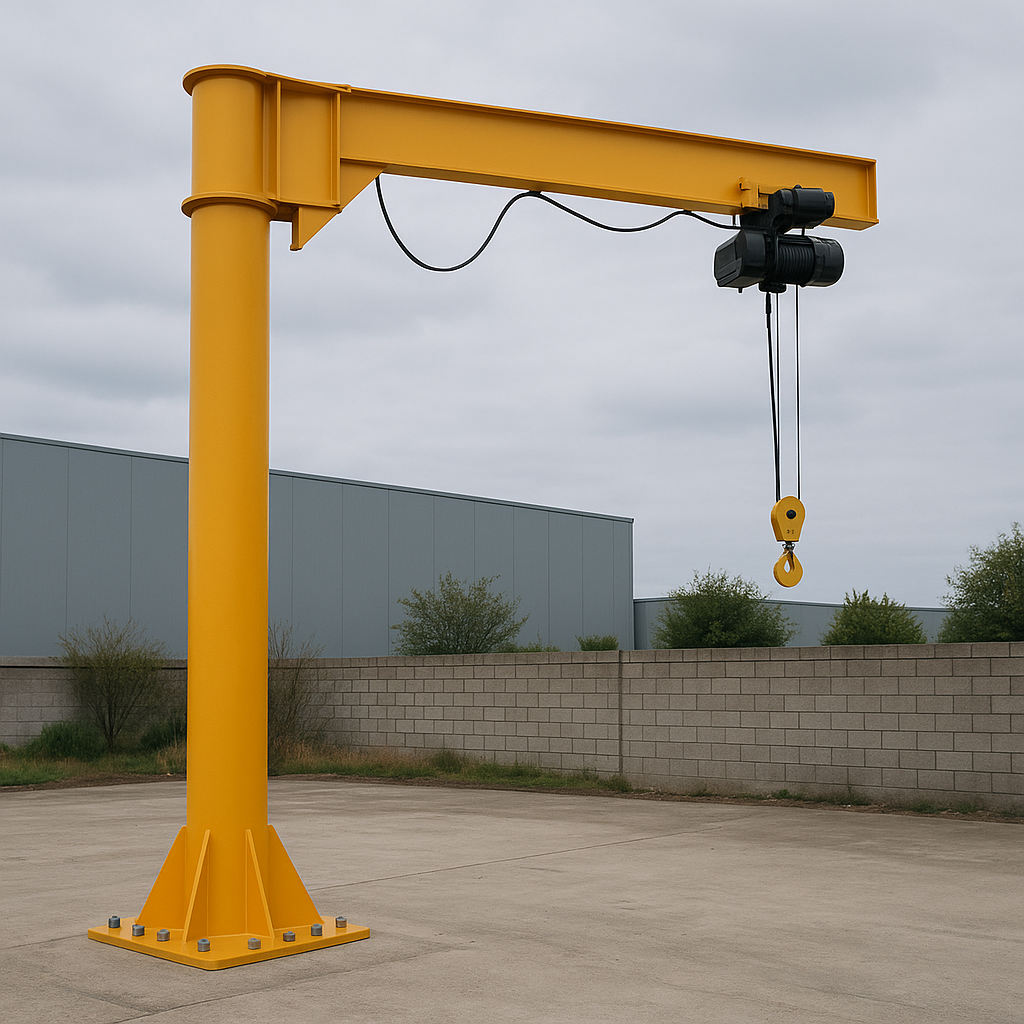Proper Jib Crane installation—whether indoor or outdoor—demands strategic planning, code compliance, and engineering precision. From choosing the right freestanding, mast-mounted, or wall-mounted jib crane to adapting for site-specific environmental factors, planning ensures the crane performs efficiently and safely over its lifecycle.
In this article, we’ll provide a comprehensive guide for planning jib crane installations tailored to both indoor and outdoor environments. Built with Experience, Expertise, Authoritativeness, and Trustworthiness—this content helps contractors, engineers, and business owners get installation right the first time.
🔧 Need installation help? Start with: Jib Crane Installation Services: How to Choose a Provider
Table of Contents
ToggleWhy Planning Is Crucial for Jib Crane Installation
A poorly planned jib crane setup can lead to:
- Misalignment and structural instability
- Operational downtime due to accessibility issues
- Safety violations and costly retrofits
- Shorter equipment lifespan
Whether it’s an indoor articulating jib crane in a warehouse or a rugged freestanding jib crane outdoors, the planning process determines long-term success.
Key Considerations for Indoor Jib Crane Installation
1. Site Assessment & Space Constraints
Indoor spaces are often limited in headroom, aisle width, and structural load-bearing capacity. Start with:
- Measuring floor-to-ceiling clearance
- Identifying walls or columns suitable for mounting
- Mapping boom rotation zones to avoid obstacles
📝 Use this checklist: Jib Crane Installation Checklist for Contractors & Teams
2. Crane Type Selection
| Crane Type | Best Use Case |
|---|---|
| Wall-mounted jib crane | Along building perimeters |
| Mast-mounted jib crane | Where overhead support is limited |
| Articulating jib crane | For handling around corners/machines |
| Freestanding jib crane | Heavy-duty 360° lifting near workstations |
📦 Browse for more jib crane products to suit your indoor application.
3. Electrical & Mechanical Integration
- Choose a compatible electric or manual hoist
- Plan cable routing to avoid trip hazards
- Confirm accessibility for future maintenance
Key Considerations for Outdoor Jib Crane Installation
1. Weather & Corrosion Resistance
Outdoor cranes require:
- Galvanized steel or powder-coated components
- Waterproof hoist enclosures
- UV-resistant wiring and controls
2. Foundation & Wind Load Engineering
Unlike indoor settings, outdoor cranes must resist:
- Wind loads per ASCE 7
- Soil movement, requiring deeper foundation anchoring
A freestanding jib crane outdoors often requires a reinforced base:
- Concrete depth: 30–50 cm minimum
- Grade rebar mesh
- Bolted anchor cage set in concrete
3. Accessibility & Material Flow
Plan the crane’s reach relative to:
- Delivery trucks
- Loading docks
- Material staging areas
This avoids future bottlenecks or logistical conflicts.
Compliance: OSHA & ANSI Standards
Installation must align with:
- OSHA 1910.179, 1910.184 for materials handling
- ANSI/ASME B30.17, B30.11, B30.2 for crane configuration and load testing
- NFPA 70 for electrical compliance
📚 Review the full guide: Jib Crane Installation Standards: OSHA & ANSI Guidelines
Differences Between Indoor and Outdoor Jib Crane Planning
| Factor | Indoor Setup | Outdoor Setup |
|---|---|---|
| Foundation Depth | Standard (based on slab) | Reinforced for wind and soil loads |
| Environmental Exposure | Low | High (sun, rain, wind, corrosion) |
| Power Supply | Easier to access | May require trenching or conduit |
| Safety Signage | Basic requirement | Additional wind and hazard labels |
| Boom Coverage | Limited swing space | Wide rotation possible |
Installation Sequence: From Prep to Operation
- Engineering Assessment
- Load calculation
- Structural review (especially for mast-type jib cranes)
- Site Prep
- Clear debris, mark anchor points
- Form and pour foundation (if needed)
- Mechanical Assembly
- Install column or mast
- Mount jib arm and hoist
- Install swing and boom restraints
- Electrical Connection
- Wire control pendant or wireless controller
- Grounding, E-stop setup
- Load Testing & Commissioning
- Perform static (100%) and dynamic (100%) load tests
- Log inspection results and certify operation
Expert Tip: Plan for Future Maintenance Access
- Leave clearance around the base, boom, and trolley
- Allow ladder or lift access for outdoor models
- Use anti-seize on anchor bolts for easier replacement
🛠 Pro installers also provide documentation and reinspection plans. Learn more: Jib Crane Installation Services: How to Choose a Provider
Common Planning Mistakes to Avoid in Jib Crane Installation
| Mistake | Result |
|---|---|
| Using indoor-rated crane outdoors | Rust, failure, and early replacement |
| Mounting on non-load-bearing walls | Structural damage or collapse |
| Skipping engineering assessment | Non-compliance and reduced load capacity |
| Poor rotation planning | Boom hitting obstructions |
| No electrical routing plan | Delays, unsafe wiring |
Final Thoughts: Plan It Right, Install It Once
Whether your application is a compact workshop or a rugged shipping yard, proper jib crane installation planning saves time, money, and future headaches. From layout mapping to load rating and foundation specs, every detail must be documented and reviewed before the first bolt is tightened.
With the right team, equipment, and regulations in place, you’ll have a crane system that delivers efficiency and safety for years to come.
✅ Explore for more jib crane products built for both indoor and outdoor excellence.

















Please log in to leave a comment.